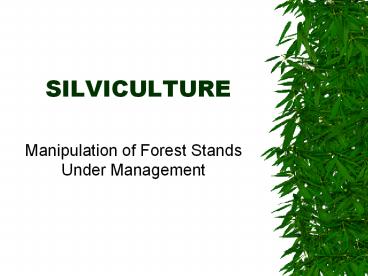SILVICULTURE - PowerPoint PPT Presentation
1 / 25
Title:
SILVICULTURE
Description:
SILVICULTURE. Manipulation of Forest Stands Under Management. Silviculture ... Silviculture (cont'd). OBJECTIVES: 1. Control of stand ... Silviculture (cont'd) ... – PowerPoint PPT presentation
Number of Views:3248
Avg rating:3.0/5.0
Title: SILVICULTURE
1
SILVICULTURE
- Manipulation of Forest Stands Under Management
2
Silviculture
- Definition The theory and practice of
controlling the establishment, density,
composition, and growth of forests for the
production of desired outputs.
3
Silviculture (contd).
- OBJECTIVES
- 1. Control of stand composition
- 2. Control of stand density
- 3. Stocking and restocking of unproductive
areas - 4. Control length of rotation
- 5. Protection and salvage of timber
- 6. Protection of site and other benefits
4
Silviculture (contd)
- Basic Ecological Principle A given acre of land
is capable of the production of a given amount of
biomass. - Silvicultural applications, for the most part,
change the form of biomass.
5
Silvicultural Tools or Techniques
- 1. Harvesting (Cutting)
- A. Regeneration harvests.
- B. Intermediate treatments.
- Thinning
- Cleaning
- etc.
- 2. Prescribed fire
6
Silvicultural Tools or Techniques
- 3. Chemical treatments
- Herbicides
- Insecticides
- Fungicides
- Used primarily to accomplish various objectives
of intermediate treatments.
7
Silvicultural Tools or Techniques
- 4. Seeding or planting
- 5. Pruning
- 6. Girdling
- 7. Fire prevention and control
8
Reproduction Systems
- Procedures by which the forest (stand) is
renewed or established, either naturally or
artificially. - Types
- High Forest vs. Low Forest
- Even-Aged vs. Uneven-Aged
9
Regeneration Harvest Systems
- Even-Aged
- Clearcutting
- Shelterwood
- Seed Tree
- Uneven-Aged
- Selection
10
Clearcutting
- Advantages
- - May be best for over-mature stands
- - Avoids logging damage to residual and
reproduction - - Minimizes concerns for windthrow
- - Often provides bare seedbed
- - Facilitates type conversion
- - Economies of operation
- Concentrates logging activity
- Reduces road building
11
Clearcutting
- Disadvantages
- - Poor site protection
- - Poor aesthetics
- - Possible losses of site fertility
- - Inappropriate for many species
- Heavy seeded
- Tolerant some situations
- - Requires diversified markets
- Size
- Species
12
Seed Tree
- Advantages
- - Good for intolerant, lighter-seeded species
- - Possibility of species control for
regeneration - - Concentration of logging activity
- - Can harvest large areas with good regeneration
13
Seed Tree
- Disadvantages
- - Poor site protection
- - Poor aesthetics
- - Seed source subject to windthrow
- - Requires wind distribution of seed
- - Timing of harvest is critical
- - Competition may hinder regeneration
14
Shelterwood
- Advantages
- - Provides reasonable site protection
- - Prepares site for seed germination
- - Proper distribution of light
- - Timing of regeneration cut for good seed
production - - Good for heavy seeded species
15
Shelterwood
- Disadvantages
- - Potential for logging damage to residual and
regeneration. - - Risk of windthrow, fire, etc.
- - Higher degree of administrative skill and time
commitment
16
Selection
- Advantages
- - Maximum of site protection
- - Selectivity of product outputs
- - Minimizes risks of windthrow, fire, etc.
- - Most aesthetic
- - May be best for small woodlots
17
Selection
- Disadvantages
- - High logging costs
- - Potential for logging damage to residual
- - Limited to shade tolerant species
- - Requires greatest degree of administrative
skill
18
Intermediate Practices
- Treatments that occur between the time of stand
establishment and the time of regeneration
harvest. - Objectives
- - Improve quality of stand
- - Protection control of mortality
- - Shorten rotation
19
Intermediate Practices
- Cleaning (Weeding)
- - Primary purpose is control of stand
composition by removal of undesirable
individuals. - - Done in immature stands, not beyond sapling
stage, usually first to twentieth year.
20
Intermediate Practices
- Thinning
- - Modifying stand structure to achieve desired
spacing. - - Purpose is to increase rate of growth of
residual stand and shorten rotation. - - May be done at any age, usually poletimber
stage or beyond.
21
Intermediate Practices
- Improvement Cutting
- - Removal of undesirable individuals to
improve overall quality of the stand. - - Normally done in stands beyond sapling stage.
- - Most needed practice for previously unmanaged
stands.
22
Intermediate Practices
- Salvage Cutting
- - Made for purposes of removing trees killed or
damaged by various agents, (fire, disease,
insects, etc.). - - Generally done when damaged material is
marketable.
23
Intermediate Practices
- Pruning
- - Removal of a portion of the limbs or crown.
- - Purposes of improving form or quality of
individuals or for stand protection.
24
Intermediate Practices
- Sanitation
- - Removal of potential disease or insect
infested trees for stand protection. - - Marketability not a significant concern.
25
Integrated Pest Management































